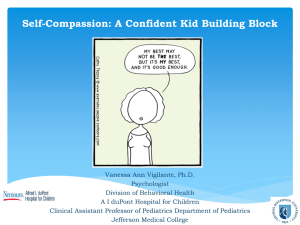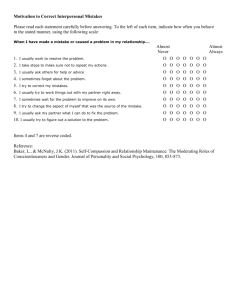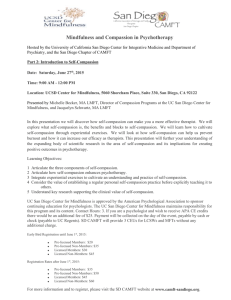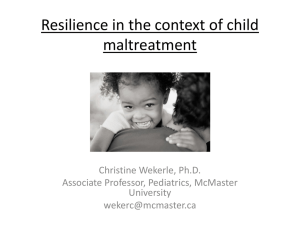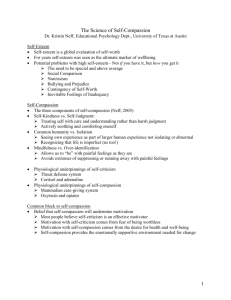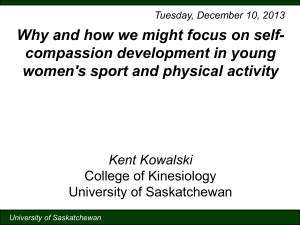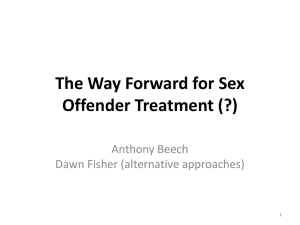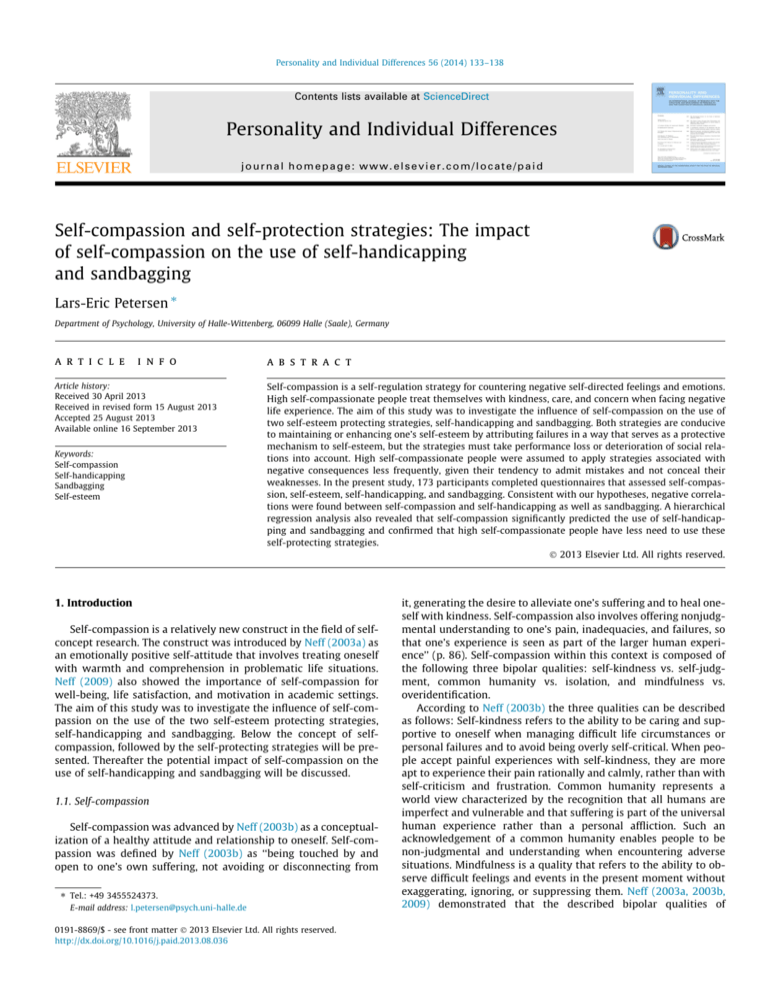
Personality and Individual Differences 56 (2014) 133–138
Contents lists available at ScienceDirect
Personality and Individual Differences
journal homepage: www.elsevier.com/locate/paid
Self-compassion and self-protection strategies: The impact
of self-compassion on the use of self-handicapping
and sandbagging
Lars-Eric Petersen ⇑
Department of Psychology, University of Halle-Wittenberg, 06099 Halle (Saale), Germany
a r t i c l e
i n f o
Article history:
Received 30 April 2013
Received in revised form 15 August 2013
Accepted 25 August 2013
Available online 16 September 2013
Keywords:
Self-compassion
Self-handicapping
Sandbagging
Self-esteem
a b s t r a c t
Self-compassion is a self-regulation strategy for countering negative self-directed feelings and emotions.
High self-compassionate people treat themselves with kindness, care, and concern when facing negative
life experience. The aim of this study was to investigate the influence of self-compassion on the use of
two self-esteem protecting strategies, self-handicapping and sandbagging. Both strategies are conducive
to maintaining or enhancing one’s self-esteem by attributing failures in a way that serves as a protective
mechanism to self-esteem, but the strategies must take performance loss or deterioration of social relations into account. High self-compassionate people were assumed to apply strategies associated with
negative consequences less frequently, given their tendency to admit mistakes and not conceal their
weaknesses. In the present study, 173 participants completed questionnaires that assessed self-compassion, self-esteem, self-handicapping, and sandbagging. Consistent with our hypotheses, negative correlations were found between self-compassion and self-handicapping as well as sandbagging. A hierarchical
regression analysis also revealed that self-compassion significantly predicted the use of self-handicapping and sandbagging and confirmed that high self-compassionate people have less need to use these
self-protecting strategies.
Ó 2013 Elsevier Ltd. All rights reserved.
1. Introduction
Self-compassion is a relatively new construct in the field of selfconcept research. The construct was introduced by Neff (2003a) as
an emotionally positive self-attitude that involves treating oneself
with warmth and comprehension in problematic life situations.
Neff (2009) also showed the importance of self-compassion for
well-being, life satisfaction, and motivation in academic settings.
The aim of this study was to investigate the influence of self-compassion on the use of the two self-esteem protecting strategies,
self-handicapping and sandbagging. Below the concept of selfcompassion, followed by the self-protecting strategies will be presented. Thereafter the potential impact of self-compassion on the
use of self-handicapping and sandbagging will be discussed.
1.1. Self-compassion
Self-compassion was advanced by Neff (2003b) as a conceptualization of a healthy attitude and relationship to oneself. Self-compassion was defined by Neff (2003b) as ‘‘being touched by and
open to one’s own suffering, not avoiding or disconnecting from
⇑ Tel.: +49 3455524373.
E-mail address: l.petersen@psych.uni-halle.de
0191-8869/$ - see front matter Ó 2013 Elsevier Ltd. All rights reserved.
http://dx.doi.org/10.1016/j.paid.2013.08.036
it, generating the desire to alleviate one’s suffering and to heal oneself with kindness. Self-compassion also involves offering nonjudgmental understanding to one’s pain, inadequacies, and failures, so
that one’s experience is seen as part of the larger human experience’’ (p. 86). Self-compassion within this context is composed of
the following three bipolar qualities: self-kindness vs. self-judgment, common humanity vs. isolation, and mindfulness vs.
overidentification.
According to Neff (2003b) the three qualities can be described
as follows: Self-kindness refers to the ability to be caring and supportive to oneself when managing difficult life circumstances or
personal failures and to avoid being overly self-critical. When people accept painful experiences with self-kindness, they are more
apt to experience their pain rationally and calmly, rather than with
self-criticism and frustration. Common humanity represents a
world view characterized by the recognition that all humans are
imperfect and vulnerable and that suffering is part of the universal
human experience rather than a personal affliction. Such an
acknowledgement of a common humanity enables people to be
non-judgmental and understanding when encountering adverse
situations. Mindfulness is a quality that refers to the ability to observe difficult feelings and events in the present moment without
exaggerating, ignoring, or suppressing them. Neff (2003a, 2003b,
2009) demonstrated that the described bipolar qualities of
134
L.-E. Petersen / Personality and Individual Differences 56 (2014) 133–138
self-compassion are highly intercorrelated and can be explained by
a single overarching factor which she referred to as self-compassion (Neff, 2003a, 2003b, 2009).
A great deal of research shows that self-compassion is positively associated with desired outcomes and negatively related to
undesired outcomes. For example, self-compassion is associated
with numerous aspects of well-being, including higher levels of social connectedness and life satisfaction (Neff, 2009, 2011) as well
as optimism and happiness (Neff, Rude, & Kirkpatrick, 2007), lower
levels of depression, anxiety and academic burn-out (Lee, 2013;
Neff, 2003b; Neff, Hseih, & Dejitthirat, 2005; Neff, Kirkpatrick, &
Rude, 2007), and more positive relationship behavior and satisfaction in romantic relationships (Baker & McNulty, 2011; Neff &
Beretvas, 2013). Furthermore, high self-compassionate people
show more intrinsic motivation in academic settings, less fear of
failure, and were more able to cope with and accept negative feedback (Neff et al., 2005). Self-compassion appeared to function as an
‘‘antidote’’ to ego threat (Neff, Kirkpatrick, et al., 2007), daily distress (Leary, Tate, Adams, Allen, & Hancock, 2007), and self-criticism (Germer, 2009). Altogether, the research indicates that high
self-compassionate people attempt to change circumstances that
they can but accept those they cannot change.
1.2. Self-handicapping and sandbagging
According to Jones and Berglas (1978), self-handicaps are
impediments to performance that people create (or claim) to protect their perceived competence which in turn maintains or enhances their self-esteem. These impediments constitute attempts
by self-handicappers to select or create settings in which feedback
on performance is ambiguous. If they fail, attribution to poor ability can be discounted because the impediment serves as a potential
cause. In the unexpected event of success, self-handicappers’ sense
of competency is enhanced, because they displayed a good performance despite the handicap. Based on Leary and Shepperd (1986),
handicapping behavior comprises two types: Behavioral handicaps
and self-reported handicaps. Behavioral handicaps refer to actual
behaviors that would impede a performance, for example, drug
and alcohol consumption (Higgins & Harris, 1988), effort withdrawal or reduction (Rhodewalt & Fairfield, 1991) and decrease
in practice (Rhodewalt, Saltzman, & Wittmer, 1984). Self-reported
handicaps, on the other hand, refer to claims of handicaps before a
performance, for example, reporting high social anxiety (Snyder &
Higgins, 1988). Uysal and Knee (2012) proposed a third form, trait
self-handicapping, which assessed by the Self-Handicapping Scale
(Jones & Rhodewalt, 1982). According to the scale items, trait
self-handicapping reflects a more chronic and habitual selfhandicapping.
Research has shown that only a moderate or occasional use of
self-handicapping strategies will protect or enhance the self-esteem. A reduction of the pressure to succeed by a suitable selfhandicapping strategy can help a person to work without anxiety
on a task and thus have a positive impact on the performance
and on the self-esteem (Deppe & Harackiewicz, 1996; Sanna &
Mark, 1995). The excessive use of self-handicapping strategies,
however, leads at least in the long term to more disadvantages
than advantages. Self-handicapping behaviors, such as taking
drugs or effort withdrawal, increase the risk of failure in achievement situations (Zuckerman, Kieffer, & Knee, 1998) and can also
cause social problems. In this regard, Rhodewalt, Sanbonmatsu,
Tschanz, Feick, and Waller (1995) showed that people claiming
to have used self-handicapping strategies before working on a task
in an experimental setting received less favorable feedback than
people performing at the same level but who had not offered
excuses.
Gibson and Sachau (2000) define sandbagging as ‘‘a self-presentational strategy involving the false prediction or feigned demonstration of inability’’ (p. 56). Research by Baumeister and
colleagues (Baumeister, 1984; Baumeister, Hamilton, & Tice,
1985) suggests that one’s expectations of success facilitate performance, whereas other people’s expectations of success inhibit performance. People using the sandbagging strategy attempt to
influence the expectations of others by creating artificially low
expectations for their performance. Sandbagging thus offers the
advantage of reducing the performance pressure and provides a
low baseline for the assessment of one’s subsequent performance
through other people.
Sandbagging could protect and enhance self-esteem by lowering the performance pressure and by the perception of performance results that is much better than predicted by the
performer and expected by the audience. In addition to these positive aspects, the application of the sandbagging strategy also has
some negative effects. First, people classified as high sandbaggers
have been shown to limit themselves to consider and explore their
abilities (Gibson, 2007). Gibson showed that high sandbaggers attempt to avoid self-relevant information when it would be made
public. This could hamper the accurate self-perception of one’s
strengths and weaknesses. Second, Gibson, Sachau, Doll, and
Shumate (2002) showed that sandbaggers who predicted lower
performance scores in a sports task performed worse in the actual
competition, which suggests that predicting worse performance
could in some cases also work as a self-fulfilling prophecy. Finally,
the use of the sandbagging strategy may also lead to the deterioration of social relationships, if evaluators, opponents, or the audience detect the deceptive intent of the claims of inability, low
levels of training, or skill.
1.3. Self-compassion and self-enhancing strategies
An essential characteristic of self-compassionate people is
attributing experiences primarily to themselves and comparing
their abilities and achievements less with others in contrast to
low self-compassionate people (Neff, 2011). Comparing with other
people is also important for people using self-handicapping and
sandbagging strategies. Clearly, though, people with high self-compassionate qualities tend to use these strategies less than people
with low self-compassion qualities. Furthermore, individuals with
high self-compassion spend less time defending their self-worth
and more on gaining experience (Neff & Vonk, 2009), and high
self-compassionate people are more willing to admit their own
mistakes and hide their weaknesses from themselves and others
less than low self-compassionate people (Neff, Rude, et al., 2007).
Based on the reviewed findings, self-compassion should therefore
be a negative predictor of both self-worth protecting strategies.
In review of the relevant literature, a clear difference emerges
between self-handicapping and self-compassion behaviors and
their respective outcomes. In this regard, Zuckerman et al. (1998)
found that self-handicapping is related to self-focused rumination,
self blame and the usage of coping strategies implying withdrawal,
and negative focus. Further, Zuckerman and Tsai (2005) reported
that self-handicapping results in a loss in competence satisfaction
and in intrinsic motivation. In contrast, high self compassion people exhibit more adaptive perceptions and behaviors. People with a
high level of self-compassion have a greater ability to assess their
own skills and greater knowledge about their own competences
than people low in self-compassion. After failures, they also attempt to learn from their mistakes to improve their ability to face
new challenges (Neff et al., 2005).
Numerous studies have also explored the relationship of selfcompassion and sandbagging with goal orientation. For example,
Gibson and Sachau (1997) found that prior to performance, high
L.-E. Petersen / Personality and Individual Differences 56 (2014) 133–138
sandbaggers reported higher levels of anxiety than low sandbaggers. Gibson and Sachau (2000) suggested that high sandbaggers
might view performance situations as unfortunate opportunities
to harm their identity, whereas low sandbaggers view performance
situations as good opportunities to demonstrate their abilities. In
contrast, several studies have found that self-compassion correlates positively with mastery goals and negatively with performance-avoidance goals (Akin, 2008; Neff et al., 2005). These
findings provide support for advancing the notion that low selfcompassionate people such as high sandbaggers avoid being in
unsuccessful performance situations and feel guilty when they fail,
whereas people with high levels in self-compassion should react
similar to low sandbaggers and should view performance situations as a chance to learn and grow as opposed to becoming consumed by fear about the possibility of negative outcomes.
Given that self-compassion has been shown to be moderately
associated with self-esteem (Hupfeld & Ruffieux, 2011; Leary
et al., 2007) it is important to show that correlations between
self-compassion and other constructs hold true even when controlling for existing levels of self-esteem. For example, when controlling for self-esteem, self-compassion was still a significant
predictor of optimism and positive affect (Neff & Vonk, 2009),
and self-compassion still was negatively correlated with depression and anxiety (Neff, 2003a). In the present study, the simultaneous inclusion of self-esteem and self-compassion is not only
important because of the overlap of the two constructs, but also
because existing studies showed significant negative correlations
between self-esteem and self-handicapping as well as self-esteem
and sandbagging (Gibson & Sachau, 2000). The aim of the present
study was to examine whether a negative correlation exists between self-compassion and self-handicapping as well as sandbagging even when controlling for self-esteem.
The following three hypotheses were formed:
Hypothesis 1: A negative correlation will be found between
self-esteem and the two self-worth protecting strategies self-handicapping and sandbagging.
Hypothesis 2: A negative correlation will be found between
self-compassion and the two self-worth protecting strategies
self-handicapping and sandbagging.
Hypothesis 3: Self-compassion will be a significant predictor of
the self-worth protecting strategies self-handicapping and sandbagging even when controlling for self-esteem.
135
and Ruffieux (2011) reported for the German version a Cronbach’s
alpha of 0.91, and in the present study Cronbach’s alpha was 0.88.
2.2.2. Self-esteem
To assess self-esteem, the German version of the Rosenberg
Self-Esteem Scale (Collani & Herzberg, 2003) was administered.
The German version showed a single- factor structure and produced expected associations with indicators of optimism, hopelessness and self-efficacy (Collani & Herzberg, 2003; Ferring &
Filipp, 1996). The scale assesses global self-esteem with 10 items.
A Cronbach’s alpha coefficient of 0.85 was reported by von Collani
and Herzberg, and in the present study Cronbach’s alpha was 0.91.
2.2.3. Self-handicapping
Self-handicapping was measured with the Self-Handicapping
Scale by Jones and Rhodewalt (1982). The scale consists of 25
items. Rhodewalt reported a Cronbach’s alpha coefficient of 0.79,
and in the present study Cronbach’s alpha was 0.81.
2.2.4. Sandbagging
Sandbagging was measured with the Sandbagging Scale by Gibson and Sachau (2000). The scale consists of 12 items. Gibson and
Sachau (2000) report a Cronbach’s alpha coefficient of 0.74, and in
the present study Cronbach’s alpha was 0.81.
2.3. Procedure
All participants completed a demographic survey for data on
age, gender, and field of study, and then completed the four assessments for self-compassion, self-esteem, self-handicapping and
sandbagging.
2.4. Data analysis
First, correlations between the predictor variables, control variables and criterions were conducted. Second, hierarchical regression analyses were performed with self-handicapping or
sandbagging entered as criterion variable. In the first step, age
and gender were entered as predictors, in the second step self-esteem was entered, and in the third step self-compassion.
3. Results
2. Method
3.1. Correlations
2.1. Participants
Table 1 shows the means, standard deviations, and intercorrelations among the variables. The self-esteem protecting strategies,
self-handicapping and sandbagging, correlated positively with
each other (r = 0.37, p < 0.01). A fairly strong correlation was found
between self-esteem and self-compassion (r = 0.66, p < 0.01) which
is in the range of r = 0.59 0.68 reported in the literature (Neff,
2003a; Neff & Vonk, 2009). Self-esteem correlated negatively with
self-handicapping (r = 0.53, p < 0.01) as well as with sandbagging
(r = 0.35, p < 0.01), thus confirming Hypothesis 1. Furthermore,
self-compassion correlated negatively with the self-esteem protecting strategies self-handicapping (r = 0.47, p < 0.01) and sandbagging (r = 0.38, p < 0.01), thus Hypothesis 2 was also
supported.
Participants were 173 students at the University of Halle-Wittenberg (65% female, 35% male), the majority of which was psychology students. The students participated voluntarily or
received experimental credits for their participation. The participants were between 18 and 30 years old, with an average age of
22.32 (SD = 2.88).
2.2. Measures
2.2.1. Self-compassion
Self-compassion was measured with Neff (2003a) Self-Compassion Scale (SCS), using the German version by Hupfeld and Ruffieux
(2011). The German version produced results comparable to results using the original six-factor scale and produced expected
associations with indicators of subjective well-being (Hupfeld &
Ruffieux, 2011). The scale consists of 26 items. Neff (2003b) reported for the scale a Cronbach’s alpha coefficient of 0.92, Hupfeld
3.2. Hierarchical regression analysis (Criterion: Self-handicapping)
Table 2 shows the results of the hierarchical regression analysis
for the criterion variable self-handicapping. The control variables,
age and gender, entered in step 1 explained 6% of the total variance
in the criterion variable. The regression weight for gender was
136
L.-E. Petersen / Personality and Individual Differences 56 (2014) 133–138
Table 1
Means, standard deviations, and intercorrelations among the variables.
Variable
M
SD
SC
SE
SH
SB
Age
Gender
3.50
3.03
3.27
3.56
22.32
1.35
0.59
0.46
0.49
0.76
2.88
0.48
SK
SC
0.15
0.62
0.04
0.08
–
–
SE
0.66**
0.47**
0.38**
0.02
0.30**
SH
0.53**
0.35**
0.01
0.20**
–
0.37**
0.12
0.18*
SB
–
0.09
0.17*
Age
Gender
–
0.14
–
Note: N = 173, SC, self-compassion; SE, self-esteem; SH, self-handicapping; SB, sandbagging. SC, SH and SB values can range from 1 to 6 and for SE values can range from 1 to 4,
with higher scores indicating more self-compassion, more self-handicapping, more sandbagging and higher self-esteem. Age in years, Gender: 1 = female, 2 = male,
SK = Skewness.
*
p < 0.05.
**
p < 0.01.
Table 2
Regression analyses with self-handicapping as the criterion.
Predictor analysis
Self-handicapping
Step 1: b
Step 1
Age
Gender
0.15
0.20*
Step 2
Self-esteem
Predictor analysis
Step 2: b
0.13
0.10
0.51***
Step 3
Self-compassion
DR2
DF
Overall R2
F
df (regression, residual)
Table 3
Regression analyses with sandbagging as the criterion.
0.06
4.9**
2, 169
0.24
59.18***
0.30
24.12***
3, 168
Step 3: b
Step 1
Age
Gender
0.13
0.06
0.38***
Step 2
Self-esteem
0.21*
Step 3
Self-compassion
DR2
DF
Overall R2
F
df (regression, residual)
0.03
5.82*
0.33
20.07***
4, 167
Note: N = 173.
p < 0.05.
**
p < 0.005.
***
p < 0.001.
Sandbagging
Step 1: b
0.07
0.16*
Step 2: b
Step 3: b
0.08
0.10
0.08
0.05
0.33***
0.17
0.25*
0.04
3.07*
2, 169
0.10
19.87***
0.14
8.90***
3, 168
0.03
6.66*
0.17
8.56***
4, 167
Note: N = 173.
p < 0.05.
**
p < 0.005.
***
p < 0.001.
*
*
significant (b = 0.20, p < 0.05), but the regression weight for age
was not (b = 0.15, ns). Entering self-esteem in step 2 led to a significant regression weight (b = 0.51, p < 0.001) and produced a
change in R2 of 0.24, p < 0.001, showing a significant influence of
self-esteem on the criterion. Consistent with Hypothesis 3, selfcompassion entered in step 3, led also to a significant regression
weight (b = 0.20, p < 0.05) and produced an additional change in
R2 of 0.03, p < 0.05.
in a way that ensures protection for their self-esteem. For this reason, the connection between self-esteem and self-handicapping as
well as sandbagging has received considerable attention in the literature. People with low self-esteem have a need to protect their
self from further devaluation (Petersen, Stahlberg, & Frey, 2006).
This argumentation has been supported by studies that found significant negative correlations between self-esteem and self-handicapping and between self-esteem and sandbagging (Gibson &
Sachau, 2000). These findings were replicated in the present study.
Furthermore, negative correlations were also found between selfcompassion and both self-protecting strategies. The hierarchical
regression analyses revealed significant regression weights for
self-compassion in addition to the traditional predictor self-esteem
with the criterion variables, self-handicapping and sandbagging.
Overall, the results support the derived hypotheses and advance
a more complete picture of people with high self-compassion values and how they interpret and approach ego threatening or failure
situations and sustain motivation in the face of failure. High
self-compassionate people attempt to gain a realistic unbiased
self-view. The use of the self-esteem protecting strategies selfhandicapping and sandbagging compromise people’s ability to
accurately see their capacities and shortcomings. High compassionate people do not need such illusions or defensiveness. They
aim to have a clearer view on their strength and weaknesses,
which supports findings by Neff and Vonk (2009). When facing
negative results, they are better able to assume personal responsibility even in the presence of others while simultaneously being
kind to themselves (Neff, Rude, et al., 2007). In contrast, people
with low self-compassion tend to use self-handicapping and
3.3. Hierarchical regression analysis (Criterion: Sandbagging)
Table 3 shows the results of the hierarchical regression analysis
for the criterion sandbagging. In the first step, age and gender explained 4% of the variance. The regression weight for gender was
significant (b = 0.16, p < 0.05), the regression weight for age was
not significant (b = 0.07, ns). In step 2, self-esteem was entered
and led to a significant regression weight (b = 0.33, p < 0.001)
and produced a significant change in R2 of 0.10, p < 0.001, indicating a significant influence of self-esteem on sandbagging. Consistent with Hypothesis 3, self-compassion entered in step 3 also
showed a significant regression weight (b = 0.25, p < 0.05) and
produced a significant change in R2 of 0.03, p < 0.05.
4. Discussion
The aim of this study was to analyze the influence of selfcompassion on the use of self-handicapping and sandbagging. Both
strategies make it possible for people to attribute possible failures
L.-E. Petersen / Personality and Individual Differences 56 (2014) 133–138
sandbagging to acquire self-protection in exchange for lower performance and a non-realistic self-view. Such a self-view can be assumed to make adaptive and successful behavior less likely in the
future. Further, this maladaptive behavior could result in a loss in
competence satisfaction and intrinsic motivation (Zuckerman &
Tsai, 2005), and low self-compassionate people might view performance situations in the same vein as sandbaggers only as unfortunate opportunities to harm their self-worth (Gibson & Sachau,
2000).
There were several limitations of this study that should be taken into account when evaluating the findings. One issue is that
the participants were mainly young university psychology students, thus the results might not easily generalize to other populations. Moreover, self-handicapping and sandbagging were assessed
with questionnaires which contain items that assess undesirable
behaviors. Participants may answer those questions untruthfully
to portray themselves as socially acceptable (social desirability
bias). Subsequent studies could benefit from the measurement of
self-handicapping and sandbagging behaviors in experimental settings. Another potential limitation can be seen in the high correlation between self-compassion and self-esteem. The observed
correlation (r = 0.66) fits in the range of correlation coefficients
detected in other studies from 0.56 (Leary et al., 2007) to 0.75
(Hupfeld & Ruffieux, 2011). These correlations raise questions
regarding the discriminant validity of these two constructs. Selfcompassion, however, can be distinguished from self-esteem on a
theoretical and empirical level. The most important conceptual difference is that self-esteem is evaluative while self-compassion is
non-evaluative: Persons can be self-compassionate to themselves
even when they do not feel good about themselves. Gilbert
(2005) set self-esteem and self-compassion in relation to biopsychosocial systems that mediate responses to threat. He argued that
self-esteem is associated with people’s evaluations of their social
rank and superiority, whereas self-compassion activates the selfsoothing system and is associated with feelings of safety. Taking
into account the patterns of relationships with other constructs,
Neff (2003b, 2011) and Neff and Vonk (2009) explained the common variance of self-esteem and self-compassion in a very similar
way. The variance accounted for by self-esteem reflects the positivity of one’s self-view, whereas the variance accounted for by selfcompassion reflects the amount of self-acceptance. Applied to
the present results, high self-esteem could have made the use of
self-handicapping and sandbagging unlikely because an overall
positive self-view cannot be easily damaged by single events. High
self-compassion, however, made the use of these two strategies
unlikely, because self-compassion makes it possible to accept supposed negative experiences and feedback.
In the past, self-esteem has often been used to explain the extent that self-handicapping and sandbagging strategies are employed. The causal interpretation, however, is unclear as to
whether low self-esteem leads to the use of the strategies or
whether the use of strategies leads to low self-esteem. In this regard, Zuckerman and Tsai (2005) offered the following explanation
of a vicious circle: People with low self-concept tend to use
self-handicapping strategies, but if the degree of self-handicapping
increases, then self-esteem further decreases. The causal interpretation, however, for self-compassion and the use of self-handicapping and sandbagging seems clear. Self-compassion should
preclude the use of self-handicapping and sandbagging, but the
causal path in the other direction that a low use of self-handicapping and sandbagging leads to self-compassion is theoretically
inconceivable. The described causal direction was not tested in
the current research. Future research could address this, for example, by testing the extent that existing programs for the enhancement of self-compassion (e.g. the Mindful Self-Compassion
Program, Neff & Germer, 2013) leads to reductions in the use of
137
self-protecting strategies. Based on these considerations and the
empirical findings in this study on the relationship between selfcompassion and the self-esteem protecting strategies self-handicapping and sandbagging, future theoretical and empirical analysis
of these strategies can benefit from considering the impact of selfcompassion.
Acknowledgments
I am grateful to Florian Henze and Diana Pietschmann for collecting the data.
References
Akin, A. (2008). Self-compassion and achievement goals: A structural equation
modeling approach. Eurasian Journal of Educational Research, 31, 1–15.
Baker, L. R., & McNulty, J. K. (2011). Self-compassion and relationship maintenance:
The moderating roles of conscientiousness and gender. Journal of Personality and
Social Psychology, 100, 853–873.
Baumeister, R. F. (1984). Choking under pressure: Self-consciousness and
paradoxical effects of incentives on skillful performance. Journal of Personality
and Social Psychology, 46, 610–620.
Baumeister, R. F., Hamilton, J. C., & Tice, D. M. (1985). Public versus private
expectancy of success: Confidence booster or performance pressure. Journal of
Personality and Social Psychology, 48, 1447–1457.
Collani, G. v., & Herzberg, P. (2003). A revised German version of Rosenberg’s selfesteem scale. Zeitschrift fuer Differentielle und Diagnostische Psychologie, 24, 3–7.
Deppe, R. K., & Harackiewicz, J. M. (1996). Self-handicapping and intrinsic
motivation: Buffering intrinsic motivation from the threat of failure. Journal of
Personality and Social Psychology, 70, 868–876.
Ferring, D., & Filipp, S.-H. (1996). Measuring of self-esteem: Findings regarding
reliability, validity, and stability of the rosenberg scale. Diagnostica, 42, 284–292.
Germer, C. K. (2009). The mindful path to self-compassion. New York: Guilford Press.
Gibson, B. (2007). The role of individual differences in sandbagging on selective
avoidance of self-evaluative information. Journal of Research in Personality, 41,
481–487.
Gibson, B., & Sachau, D. A. (1997). Mood of high and low sandbaggers in
performance settings. In:Poster presented at the 69th annual meeting of the
Midwestern Psychological Association, Chicago.
Gibson, B., & Sachau, D. A. (2000). Sandbagging as a self-presentational strategy:
Claiming to be less than you are. Personality and Social Psychology Bulletin, 26,
56–70.
Gibson, B., Sachau, D. A., Doll, B., & Shumate, R. (2002). Sandbagging in competition:
Responding to the pressure of being the favorite. Personality and Social
Psychology Bulletin, 28, 1119–1130.
Gilbert, P. (2005). Compassion and cruelty: A biopsychosocial approach. In P. Gilbert
(Ed.), Compassion: Conceptualisations, research and use in psychotherapy
(pp. 9–74). London: Routledge.
Higgins, R. L., & Harris, R. N. (1988). Strategic ‘‘alcohol’’ use: Drinking to selfhandicap. Journal of Social and Clinical Psychology, 6, 191–202.
Hupfeld, J., & Ruffieux, N. (2011). Validation of a German version of the selfcompassion scale (SCS-D). Zeitschrift fuer Klinische Psychologie und
Psychotherapie, 40, 115–123.
Jones, E. E., & Berglas, S. (1978). Control of attributions about the self through selfhandicapping strategies: The appeal of alcohol and the role of
underachievement. Personality and Social Psychology Bulletin, 4, 200–206.
Jones, E. E., & Rhodewalt, F. (1982). The self-handicapping scale. Salt Lake City:
University of Utah.
Leary, M. R., & Shepperd, J. A. (1986). Behavioral self-handicaps versus self-reported
self-handicaps: A conceptual note. Journal of Personality and Social Psychology,
77, 1041–1060.
Leary, M. R., Tate, E. B., Adams, C. E., Allen, A. B., & Hancock, J. (2007). Selfcompassion and reactions to unpleasant self-relevant events: The implications
of treating oneself kindly. Journal of Personality and Social Psychology, 92,
887–904.
Lee, W. K. (2013). Self-compassion as a moderator of the relationship between
academic burn-out and psychological health in Korean Cyber University
students. Personality and Individual Differences, 54, 899–902.
Neff, K. D. (2003a). Development and validation of a scale to measure selfcompassion. Self and Identity, 2, 223–250.
Neff, K. D. (2003b). Self-compassion: An alternative conceptualization of a healthy
attitude toward oneself. Self and Identity, 2, 85–102.
Neff, K. D. (2009). Self-compassion. In M. R. Leary & R. H. Hoyle (Eds.), Handbook of
individual differences in social behavior (pp. 561–573). Guilford Press.
Neff, K. D. (2011). Self-compassion, self-esteem, and well-being. Social and
Personality Compass, 5, 1–12.
Neff, K. D., & Beretvas, S. N. (2013). The role of self-compassion in romantic
relationships. Self and Identity, 12, 78–98.
Neff, K. D., & Germer, C. K. (2013). A pilot study and randomized controlled trial of
the mindful self-compassion program. Journal of Clinical Psychology, 69, 28–44.
Neff, K. D., Hseih, Y., & Dejitthirat, K. (2005). Self-compassion, achievement goals,
and coping with academic failure. Self and Identity, 4, 263–287.
138
L.-E. Petersen / Personality and Individual Differences 56 (2014) 133–138
Neff, K. D., Kirkpatrick, K., & Rude, S. S. (2007). Self-compassion and its link to
adaptive psychological functioning. Journal of Research in Personality, 41,
139–154.
Neff, K. D., Rude, S. S., & Kirkpatrick, K. (2007). An examination of self-compassion in
relation to positive psychological functioning and personality traits. Journal of
Research in Personality, 41, 908–916.
Neff, K. D., & Vonk, R. (2009). Self-compassion versus global self-esteem: Two
different ways of relating to oneself. Journal of Personality, 77, 23–50.
Petersen, L. E., Stahlberg, D., & Frey, D. (2006). Self-esteem. In H. W. Bierhoff & D.
Frey (Eds.), Handbook of Social Psychology and Communication Psychology
(pp. 40–48). Göttingen: Hogrefe.
Rhodewalt, F., & Fairfield, M. L. (1991). Claimed self-handicapping and the selfhandicapper: The relation of reduction in intended effort to performance.
Journal of Research in Psychology, 25, 402–407.
Rhodewalt, F., Saltzman, A. T., & Wittmer, J. (1984). Self-handicapping among
competitive athletes: The role of self-esteem protection. Basic and Applied Social
Psychology, 5, 197–209.
Rhodewalt, F., Sanbonmatsu, D. M., Tschanz, B., Feick, D. L., & Waller, A. (1995). Selfhandicapping and interpersonal trade-offs: The effects of claimed selfhandicaps on observerśperformance evaluations and feedback. Personality and
Social Psychology Bulletin, 21, 1042–1050.
Sanna, L. J., & Mark, M. M. (1995). Self-handicapping, expected evaluation, and
performance: Accentuating the positive and attenuating the negative.
Organizational Behavior and Human Decision Processes, 64, 84–102.
Snyder, C. R., & Higgins, R. L. (1988). Excuses: Their effective role in the negotiation
of reality. Psychological Bulletin, 104, 23–35.
Uysal, A., & Knee, C. R. (2012). Low trait self-control predicts self-handicapping.
Journal of Personality, 80, 59–79.
Zuckerman, M., Kieffer, S. C., & Knee, C. R. (1998). Consequences of selfhandicapping: Effects on coping, academic performance, and adjustment.
Journal of Personality and Social Psychology, 74, 1619–1628.
Zuckerman, M., & Tsai, F. (2005). Costs of self-handicapping. Journal of Personality,
73, 411–442.

